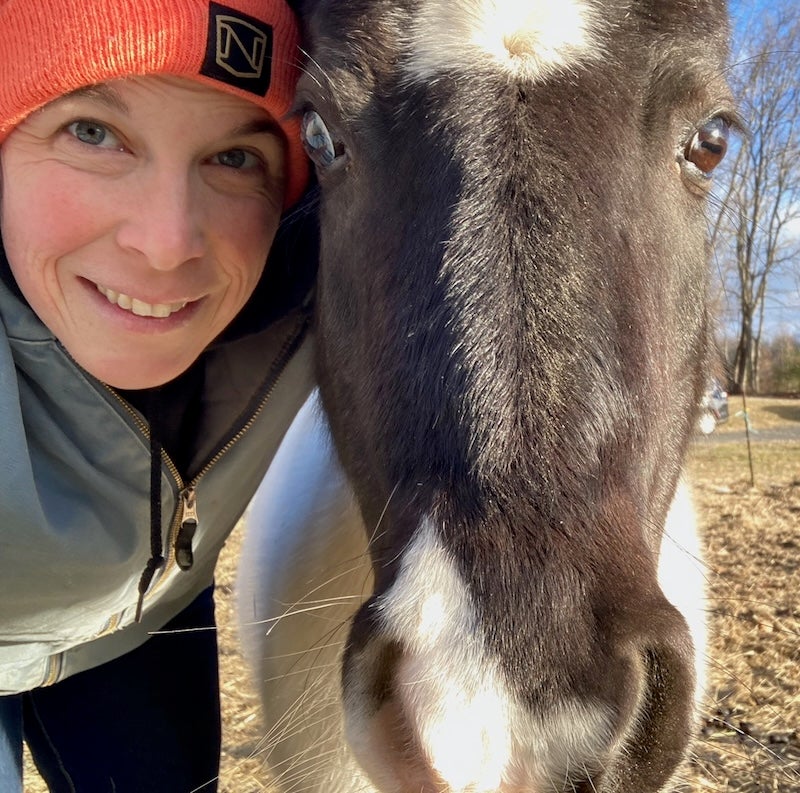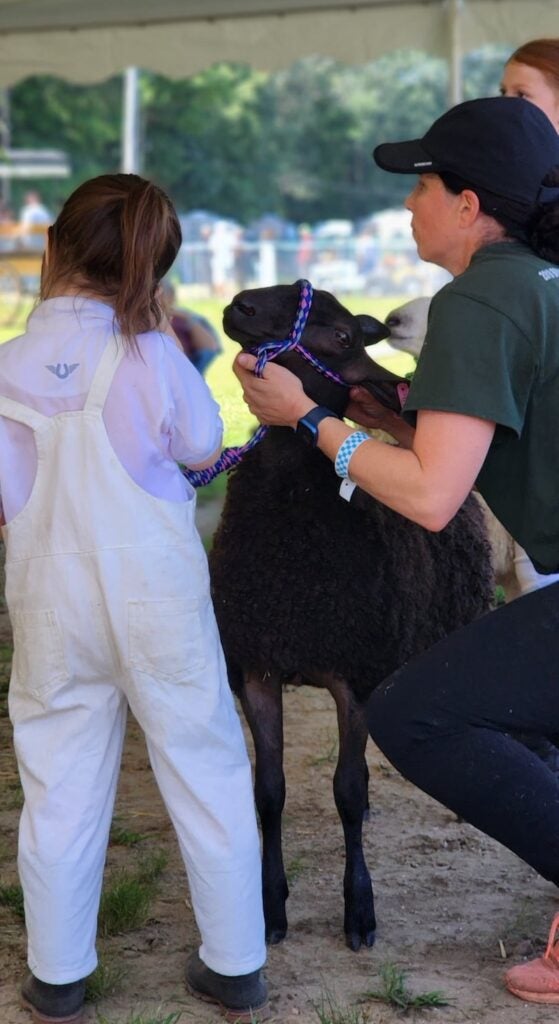Maria Peterson, assistant professor of fisheries, animal, and veterinary science, teaches AVS 101: Introduction to Animal Science and AVS 304: Advanced Animal Management Techniques. Through these courses, she introduces students to their first semester in the pre-vet and animal science programs, noting that she enjoys watching them grow and learning to work with animals in a clinical setting. Hoffman’s passion for helping animals and teaching students can be seen through her courses that center on student growth, a nurturing environment, and hands-on learning.
Q. How would you describe your teaching philosophy/pedagogy?
A. The central goal of my courses is to help my students learn and retain new information or skills in a safe learning environment that facilitates student growth. I strive to create a nurturing environment for students. This does not mean that I do not provide rigorous courses but rather a comfortable space for them to learn the information, determine their knowledge base and encourage growth. I explain to all my students that these courses are like “sand boxes” where you can play around with the information we are working with and build something great, but this takes practice. A great deal of my pedagogy has been shaped by my own personal challenges that I have encountered during my academic journey or the journeys of others that I have worked, taught, and learned with. I have experienced first hand and witnessed how when life throws us curve balls, that this can impact our ability to learn and recall information in ways that we never imagined (and there is a great deal of frustration and embarrassment that comes with it). Everyone learns differently and needs to feel accepted and understand that regardless of how they learn, they belong here at URI.
Describe one of your most memorable teaching experiences.
It’s hard to pick just one! For AVS 101, I am fortunate because this is an experience I get to see every fall semester. The freshmen join the University, and our new pre-vet and animal science majors join the program. As the professor in AVS 101, I get to watch them grow. They often begin as timid, new students and over the course of the semester, I get to watch them develop core groups of friends that they sit with and walk to/from class with. I get to watch their confidence and comfort level with the content and the course grow. When they walk out the door in December, they have grown and changed so much from the students that walk through the doors in September. It is really amazing to see. My other very memorable teaching experiences center around my AVS 304 lab. We often get to see animals giving birth or we get to ultrasound the pregnant ewes (so the students get to see the lambs growing in utero). I get to see the students’ eyes light up with complete wonder at what they are seeing and learning. I get to see them learn how to collect blood from different animals, which can be super nerve wracking. But I get to watch them shaking with excitement (and some pent up nerves) after successfully collecting their first sample. I consider myself very lucky to be able to witness this.
What is one lesson you hope your students take away from your courses besides the content being covered?
It’s OK to not always have the answer or know how to do something. That’s what learning is all about! We get to try something new, and we might not be that great at it at first, but that is normal. It’s all about growth.
What has been the most surprising or unexpected part of teaching?
The most unexpected thing about teaching is how much you pull from your own in-class experiences and use that to create a better environment for your students. When I first started teaching as a grad student/postdoc, it was mostly guest lecturing in someone else’s class, and you are so worried about content. But once I had my own courses, I was finally able to focus on content creating a conducive learning environment. I know what it is like to be timid in class, anxious taking exams, and fearing failure. Those are normal emotions for students, but I want to create a space that lessens those and helps the students learn how to effectively cope with them, learn, and move forward.

Who was the most inspiring teacher in your life and why?
This is a tricky question and one I had to really think about. It is hard for me to pick one person in a teaching/professor role that was an inspiration to me. But I would have to say that the animals I have worked with have been a form of teacher that has significantly inspired and influenced me. I have grown up with animals since I was a child, starting off with hamsters that I kept in my room in our small house in North Providence as a kid. Once my family moved, I eventually graduated to bigger animals, like sheep and other livestock. They inspired me to learn everything I could about animals. I also learned how to speak their “languages” through the time I spent with them and learned how to care for them. They also taught me hard lessons. I learned about different diseases and conditions that could make them sick, how to prevent them from happening, and what to do if they did. I learned that persistence pays off and through hard work, dedication, patience, and lots of care you can save animals. I also learned that sometimes, even when we try our hardest and do everything right, they still pass away. And while we might be gutted by that, we have to do the best we can moving forward and continue to care for others the best that we can. So in many ways, they taught me resilience and persistence. Working with animals is what took me on my journey to getting my PhD. I wanted to find ways to help animals and develop new ways to improve their health.
How do you incorporate hands-on learning into your courses?
In my classroom-based classes, we do write-pair-share activities, we have in-class discussions, and I have recently been incorporating more KaHoot! And Jeopardy games (the students love these). In my AVS 304 class, we are on the farm once a week collecting blood, giving vaccinations, collecting body weights, and handling all of the farm animals.

Why do you think it’s important to teach about animal and veterinary science?
Animals are an integral part of our lives. They are our companions and yield products that some of us use every day without even thinking about it. There are so many careers that students can have in this field because of this. It’s also important for students to understand the role that animals play in their lives and how to be stewards to them.
How has your research influenced your teaching?
In many ways. It has helped me have a strong relationship with the content that I am teaching. It has allowed me to also think about the applications of my research and encourage the next generation of animal scientists to start asking questions and making connections.

